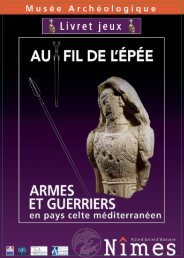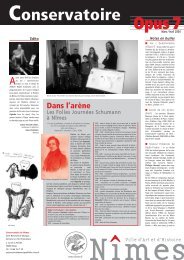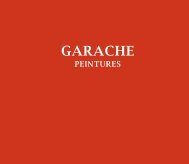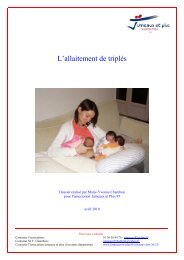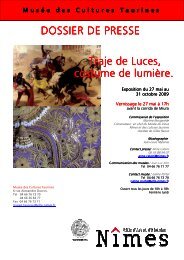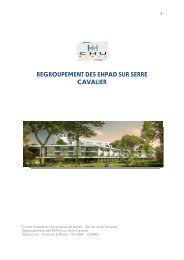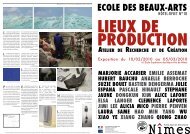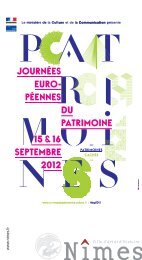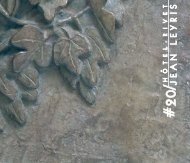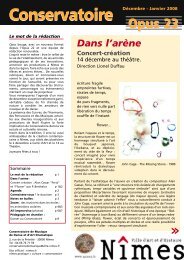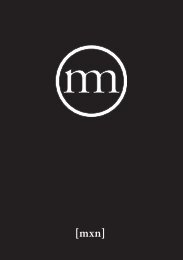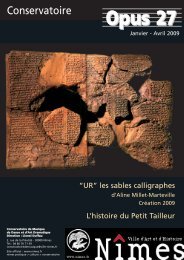.Presentation of the school - Nîmes
.Presentation of the school - Nîmes
.Presentation of the school - Nîmes
Create successful ePaper yourself
Turn your PDF publications into a flip-book with our unique Google optimized e-Paper software.
54<br />
E.S.B.A.N. teaching staff<br />
Jean-Marc CERINO<br />
Born in Jallieu in 1965.<br />
Jean-Marc Cerino’s work addresses <strong>the</strong> representation <strong>of</strong> people<br />
met in various situations <strong>of</strong> life or even isolated from society. This is<br />
seen in Dépositions I, II and III made with homeless men and women,<br />
patients at a psychiatric centre or people in prison. In <strong>the</strong>se wax-treated<br />
white paintings, with close shades, two apparently contradictory gestures<br />
occur that meet, telescope and converse without neutralising or<br />
contradicting each o<strong>the</strong>r: that <strong>of</strong> <strong>the</strong> representation <strong>of</strong> <strong>the</strong>se persons<br />
and that <strong>of</strong> <strong>the</strong> monochromatic covering layer. This creates tension at<br />
<strong>the</strong> level <strong>of</strong> <strong>the</strong> canvas between surface and depth, between <strong>the</strong> figures<br />
represented and <strong>the</strong> background that <strong>the</strong>y are tearing <strong>the</strong>mselves from.<br />
‘What is meant by this monochromatic base, this empty, abyssal<br />
base, is a kind <strong>of</strong> deterritorialisation <strong>of</strong> <strong>the</strong>se lives, <strong>the</strong>ir tearing away<br />
or <strong>the</strong> shifting <strong>of</strong> <strong>the</strong> socio-economic context in which <strong>the</strong>y have become<br />
and are kept invisible for <strong>the</strong>ir recontextualisation or reterritorialisation<br />
in <strong>the</strong> “bottomless base” <strong>of</strong> singular-plural, <strong>of</strong> <strong>the</strong> “with” or <strong>the</strong><br />
“in common”.<br />
Jean-Marc Cerino - Le lieu en <strong>of</strong>frande.<br />
Michel Gaillot.<br />
‘In <strong>the</strong>se figures painted by Jean-Marc Cerino, whiteness is<br />
both a veil and simultaneously a kind <strong>of</strong> revealer ; it is whiteness that<br />
must not be torn […] so as not to sink into too expressive a white or an<br />
over-abundance <strong>of</strong> words that will smo<strong>the</strong>r <strong>the</strong> figure. This is what is<br />
grasped astonishingly well in <strong>the</strong> between-two <strong>of</strong> Jean-Marc Cerino’s<br />
work. It is never too much and never less. And at <strong>the</strong> same time you feel<br />
very clearly that <strong>the</strong> slightest hitch can tip everything over into something<br />
terrifying’.<br />
L’inconvenance du corps.<br />
Daniel Dobbels.<br />
Regular exhibitions in France and abroad, represented by <strong>the</strong> Bernard<br />
Ceysson gallery (Saint-Etienne / Luxembourg).<br />
Writings in publications or catalogues devoted to Jean-Marc<br />
Cerino’s work<br />
Karim Ghaddab, Inventaire après liquidation, in… dans les lanières des<br />
seuils, collection Varia, Fage éditions, 2008.<br />
Daniel Dobbels, L’inconvenance du corps, collection Hôtel-Rivet, # 22,<br />
éditions Esban 2008.<br />
Bernard Stiegler, Le temps de la prison, in Dépositions III, 2006.<br />
Michel Gaillot, Jean-Marc Cerino - Le lieu en <strong>of</strong>frande,<br />
Villa du Parc, Annemasse 2005.<br />
Itzhak Goldberg, L’impression de la mémoire, in “Jean-Marc Cerino -<br />
Savoir, c’est se souvenir”, Musée de Bourgoin-Jallieu, 2000.<br />
Jean-Luc Nancy, Passage.<br />
Jean-Claude Conésa, Esse, est percip.<br />
Être, c’est être perçu, Éditions des Cahiers Intempestifs,<br />
Saint-Etienne 1999.<br />
Jacques Beauffet, Jean-Marc Cerino,<br />
Sicmmat Art Contemporain, 1996.<br />
Jean-Marc Cerino is also a member <strong>of</strong> <strong>the</strong> editorial board <strong>of</strong> <strong>the</strong> journal<br />
De(s)générations.<br />
Passage de témoins/Témoin de passages,<br />
La Galerie de l’artothèque, Bibliothèque de la Part-Dieu, Lyon,<br />
24 April - 10 July 2004.<br />
Photo : Pierre Arnaud



